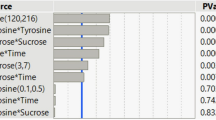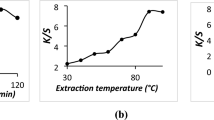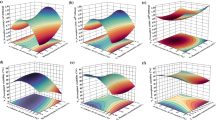Abstract
Consumer choice is typically influenced by color, leading to an increase in the use of artificial colorants by industry. However, several artificial colorants have been banned due to their harmful effects on human health and the environment, leading to increased interest in colorants from natural sources. Natural colorants can be found in plants, insects, and microorganisms. The importance of evaluating the technical and cost feasibility for the production of natural colorants are important factors for the replacement of artificial counterpart. Therefore, it is highly beneficial to predict the productivity of microbial colorants. The use of statistical methods that generate polynomial models through multiple regressions can provide information of interest about a bioprocess. However, modeling and control of biological processes require complex systems models, because they are nonlinear and non-deterministic systems. In this regard, artificial neural networks are suitable for estimating bioprocess variables with systems modeling. In this work, two different strategies were developed to predict the production of red colorants by Talaromyces amestolkiae, namely simulation by artificial neural networks (ANN) and response surface methodology (RSM). The results showed that the colorant concentration predicted by ANN is closer to the experimental data than that predicted by polynomial models fitted by multiple regression. Thus, this work suggests that the use of ANN can identify the initial conditions of the culture parameters that have the greatest influence on colorant production and can be a tool to be employed to improve the production of biotechnological products, such as microbial colorants.




Similar content being viewed by others
Data availability
The authors declare that the data supporting the findings of this study are available within the article.
References
Morales-Oyervides L, Ruiz-Sánchez JP, Oliveira JC, Sousa-Gallagher MJ, Méndez-Zavala A, Giuffrida D, Dufossé L, Montañez J (2020) Biotechnological approaches for the production of natural colorants by Talaromyces/Penicillium: a review. Biotechnol Adv. https://doi.org/10.1016/j.biotechadv.2020.107601
Lehto S, Buchweitz M, Klimm A, Straßburger R, Bechtold C, Ulberth F (2017) Comparison of food colour regulations in the EU and the US: a review of current provisions. Food Addit Contam Part A Chem Anal Control Expo Risk Assess 34:335–355. https://doi.org/10.1080/19440049.2016.1274431
Sen T, Barrow CJ, Deshmukh SK (2019) Microbial pigments in the food industry—challenges and the way forward. Front Nutr 6:1–14. https://doi.org/10.3389/fnut.2019.00007
Sharma J, Sharma S, Soni V (2021) Classification and impact of synthetic textile dyes on Aquatic Flora: a review. Reg Stud Mar Sci. https://doi.org/10.1016/j.rsma.2021.101802
Lagashetti AC, Dufossé L, Singh SK, Singh PN (2019) Fungal pigments and their prospects in different industries. Microorganisms 7:1–36. https://doi.org/10.3390/microorganisms7120604
Mordor Intelligence, Natural food colorants market: growth, trend, COVID-19 impact, and forecast (2022–2027). Available online:, mordorintelligence.com/industry-reports/global-natural-food-colorants-market. Accessed 7 Febr. 2022. (2021)
Torres FAE, Zaccarim BR, de Lencastre Novaes LC, Jozala AF, dos Santos CA, Teixeira MFS, Santos-Ebinuma VC (2016) Natural colorants from filamentous fungi. Appl Microbiol Biotechnol 100:2511–2521. https://doi.org/10.1007/s00253-015-7274-x
Chen W, Chen R, Liu Q, He Y, He K, Ding X, Kang L, Guo X, Xie N, Zhou Y, Lu Y, Cox RJ, Molnár I, Li M, Shao Y, Chen F (2017) Orange, red, yellow: biosynthesis of azaphilone pigments in Monascus fungi. Chem Sci 8:4917–4925. https://doi.org/10.1039/C7SC00475C
Mapari SAS, Thrane U, Meyer AS (2010) Fungal polyketide azaphilone pigments as future natural food colorants? Trends Biotechnol 28:300–307. https://doi.org/10.1016/j.tibtech.2010.03.004
Caro Y, Anamale L, Fouillaud M, Laurent P, Petit T, Dufosse L (2012) Natural hydroxyanthraquinoid pigments as potent food grade colorants: an overview. Nat Products Bioprospect 2:174–193. https://doi.org/10.1007/s13659-012-0086-0
Yang J, Chen Q, Wang W, Hu J, Hu C (2015) Effect of oxygen supply on Monascus pigments and citrinin production in submerged fermentation. J Biosci Bioeng 119:564–569. https://doi.org/10.1016/j.jbiosc.2014.10.014
Teixeira MFS, Martins MS, da Silva JC, Kirsch LS, Fernandes OCC, Carneiro ALB, de Conti R, Durán N (2012) Amazonian biodiversity: Pigments from Aspergillus and Penicillium-characterizations, antibacterial activities and their Toxicities. Curr Trends Biotechnol Pharm 6:300–311
Mapari SAS, Hansen ME, Meyer AS, Thrane U (2008) Computerized screening for novel producers of Monascus-like food pigments in Penicillium species. J Agric Food Chem 56:9981–9989. https://doi.org/10.1021/jf801817q
de Oliveira F, Rocha ILD, Claudia Gouveia Alves Pinto D, Ventura SPM, Gonzaga A, dos Santos E, De José Crevelin V, Ebinuma CS (2022) Identification of azaphilone derivatives of Monascus colorants from Talaromyces amestolkiae and their halochromic properties. Food Chem. https://doi.org/10.1016/j.foodchem.2021.131214
de Oliveira F, Pedrolli DB, Teixeira MFS, de Carvalho Santos-Ebinuma V (2019) Water-soluble fluorescent red colorant production by Talaromyces amestolkiae. Appl Microbiol Biotechnol 103:6529–6541. https://doi.org/10.1007/s00253-019-09972-z
de Oliveira F, Ferreira LC, Neto ÁB, Simas Teixeira MF, de Carvalho Santos V, Ebinuma, (2020) Biosynthesis of natural colorant by Talaromyces amestolkiae: Mycelium accumulation and colorant formation in incubator shaker and in bioreactor. Biochem Eng J. https://doi.org/10.1016/j.bej.2020.107694
Abdul Manan M, Ariff A, Mohamad R, Abdul Karim M (2005) Kinetics and modeling of red pigment fermentation by Monascus purpureus FTC 5391 in 2-litre stirred tank fermenter using glucose as a carbon source. J Trop Agric Food Sci 33:277–284
Panagou EZ, Skandamis PN, Nychas GJE (2003) Modelling the combined effect of temperature, pH and aw on the growth rate of Monascus ruber, a heat-resistant fungus isolated from green table olives. J Appl Microbiol 94:146–156. https://doi.org/10.1046/j.1365-2672.2003.01818.x
Santos-Ebinuma VC, Roberto IC, Simas Teixeira MF, Pessoa A (2013) Improving of red colorants production by a new Penicillium purpurogenum strain in submerged culture and the effect of different parameters in their stability. Biotechnol Prog 29:778–785. https://doi.org/10.1002/btpr.1720
Tolborg G, Ødum ASR, Isbrandt T, Larsen TO, Workman M (2020) Unique processes yielding pure azaphilones in Talaromyces atroroseus. Appl Microbiol Biotechnol 104:603–613. https://doi.org/10.1007/s00253-019-10112-w
Zhou B, Wang J, Pu Y, Zhu M, Liu S, Liang S (2009) Optimization of culture medium for yellow pigments production with Monascus anka mutant using response surface methodology. Eur Food Res Technol 228:895–901. https://doi.org/10.1007/s00217-008-1002-z
V.C. Liyanaarachchi, M. Premaratne, P.H. Viraj Nimarshana, T. Udayangani Ariyadasa, Investigation of the Effect of Organic and Inorganic Carbon on Biomass Production and Astaxanthin Accumulation of the Microalga Haematococcus pluvialis Using Artificial Neural Network, 2020 IEEE 17th India Counc Int Conf INDICON 2020. (2020). https://doi.org/10.1109/INDICON49873.2020.9342373
Sommer R, Paxson V (2010) Outside the closed world: On using machine learning for network intrusion detection. Proc IEEE Symp Secur Priv. https://doi.org/10.1109/SP.2010.25
Karim MN, Yoshida T, Rivera SL, Saucedo VM, Eikens B, Gyu-Seop OH (1997) Global and local neural network models in biotechnology: Application to different cultivation processes. J Ferment Bioeng 83:1–11. https://doi.org/10.1016/S0922-338X(97)87318-7
Singh N, Goel G, Singh N, Pathak BK, Kaushik D (2015) Modeling the red pigment production by Monascus purpureus MTCC 369 by Artificial Neural Network using rice water based medium. Food Biosci 11:17–22. https://doi.org/10.1016/j.fbio.2015.04.001
Durakli-Velioǧlu S, Boyaci IH, Şimşek O, Gümüş T (2013) Optimizing a submerged Monascus cultivation for production of red pigment with bug damaged wheat using artificial neural networks. Food Sci Biotechnol 22:1639–1648. https://doi.org/10.1007/s10068-013-0261-z
Jokić A, Pajčin I, Grahovac J, Lukić N, Ikonić B, Nikolić N, Vlajkov V (2020) Dynamic modeling using artificial neural network of bacillus velezensis broth cross-flow microfiltration enhanced by air-sparging and turbulence promoter. Membranes (Basel) 10:1–14. https://doi.org/10.3390/membranes10120372
Haykin S (2001) Neural Networks: a comprehensive foundation. 2. ed. Delhi, Índia: Pearson Education 1:33.
Sewsynker-Sukai Y, Faloye F, Kana EBG (2016) Artificial neural networks: an efficient tool for modelling and optimization of biofuel production (a mini review). Biotechnol Biotechnolog Equip 31:221–235. https://doi.org/10.1080/13102818.2016.1269616
Acknowledgements
This work was supported by São Paulo Research Foundation (FAPESP)—Brazil [Grant no. FAPESP 2014/01580-3, 2019/15493-9, 2021/06686-8, 2021/09175-4]. V.C. Santos-Ebinuma thanks the National Council of Scientific and Technological Development, Brazil (Conselho Nacional de Desenvolvimento Científico e Tecnológico—CNPq)—proc. no. 312463/2021-9 and PIBIC program from CNPq. The authors also acknowledge the support from CAPES (Coordenação de Aperfeiçoamento de Pessoal de Nível Superior, Brazil), finance code 001.
Author information
Authors and Affiliations
Corresponding author
Ethics declarations
Conflict of interest
The authors declare that they have no interest in conflict with the work described in this paper.
Additional information
Publisher's Note
Springer Nature remains neutral with regard to jurisdictional claims in published maps and institutional affiliations.
Rights and permissions
Springer Nature or its licensor (e.g. a society or other partner) holds exclusive rights to this article under a publishing agreement with the author(s) or other rightsholder(s); author self-archiving of the accepted manuscript version of this article is solely governed by the terms of such publishing agreement and applicable law.
About this article
Cite this article
dos Reis, B.D., de Oliveira, F., Santos-Ebinuma, V.C. et al. Assessment of artificial neural networks to predict red colorant production by Talaromyces amestolkiae. Bioprocess Biosyst Eng 46, 147–156 (2023). https://doi.org/10.1007/s00449-022-02819-4
Received:
Accepted:
Published:
Issue Date:
DOI: https://doi.org/10.1007/s00449-022-02819-4




